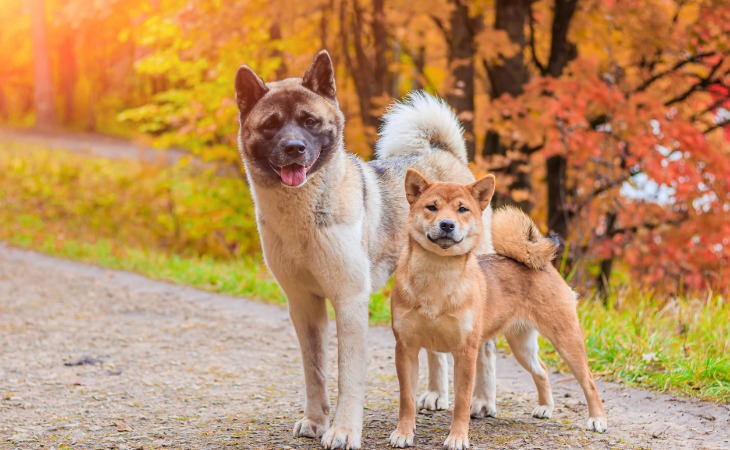Japanese dog breeds are getting more and more popular! We love them not only because they are adorable, but also because of their many qualities. In this article, we will introduce you to 5 Japanese dog breeds!
1. Shikoku, a rare Japanese dog breed
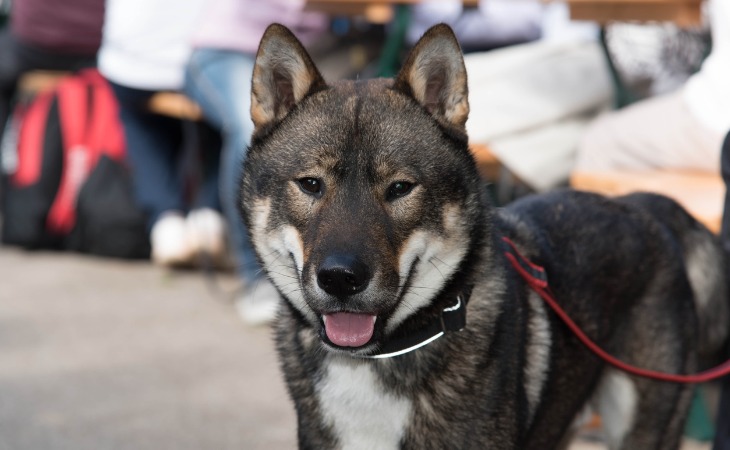
The origins of the Shikoku
Shikoku dogs are named after Shikoku Island, where they originated from. They are very rarely found outside of Japan. This breed is a medium-sized dog breed and is considered a spitz dog breed.
Shikoku Island is a very mountainous region. In the past, the ancestors of this dog breed were mainly used for hunting animals, such as deer and wild boar. There were three varieties of the Shikoku dog breed that were developed: the Hata, the Hongawa and the Awa.
Nowadays, there are two types of Shikoku dogs. Shikoku dogs that are used for hunting, which are quite thin and long, and Shikoku companion dogs, which are intended for adoption and have a much stockier body.
Physical characteristics
Shikoku dogs have a nice sesame color coat. That being said, there is a difference between the coats of dogs in Japan and those found in the West. In Japan, Shikokus more often have a red sesame color coat. Conversely, in the West, we typically find Shikoku dogs with a sesame and black coat.
They are a medium-sized dog breed and look quite similar to the Shiba Inu and the Akita Inu. On their muzzle, neck, belly and the inside of his legs and tail, there should be Urajiro. This is a white or cream marking.
Personality
This Japanese dog breed is rather brave. However, their great curiosity can makes them a rather stubborn dog. Some positive traits that the Shikoku has is its loyalty and closeness to its owner. They are playful and affectionate, but they need some independence.
The Shikoku needs firm and consistent training. Positive reinforcement and using your voice works well with this dog and they learn very quickly. Lastly, it is important to socialize them from a very young age.
Caring for a Shikoku
If you live in an apartment, it is not recommended to adopt a Shikoku. This breed needs a lot of activities.
The Shikoku is a very robust dog with no notable health problems. They live on average between 12 and 13 years.
2. Japanese Spitz, a small white dog breed
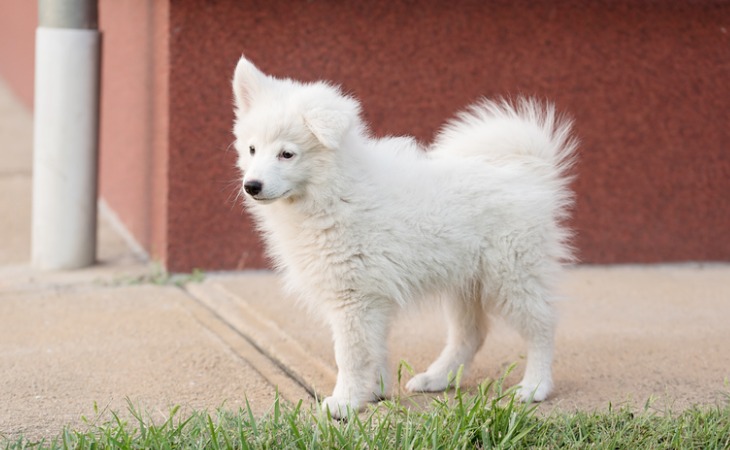
The origins of the Japanese Spitz
The Japanese Spitz descended from the large German Spitz. They came to Japan in the 1920s. One of the reasons why they are so popular is because of their elegant physique.
In 1921, they made their first official appearance at an exhibition in Tokyo. Since 1921, breeders crossed the breed several times to improve and stabilize them. The breed was officially recognized in 1948 by the Japanese Kennel Club.
Physical characteristics
The Japanese Spitz is a small dog breed. Its coat must be pure white. That being said, it is not very complicated to groom this breed. To avoid tangling and knots, you can brush their coat regularly. In addition, this breed is very graceful. They adapt well to different variations and react well to the cold.
Personality
This Japanese dog breed is very affectionate. However, they do not really trust strangers and can barkat them to keep them at bay. For this reason, the Japanese Spitz is known to be a good guard dogs.
As well as that; the Japanese Spitz can also be a very playful dog. Similar to other Japanese dog breeds, the Spitz is affectionate but still needs some independence.
Caring for a Japanese Spitz
This dog breed is great for families with children. In addition, they have no particular genetic predisposition to disease. They are generally healthy dogs that typically live between 10 and 16 years.
3. Japanese Chin, a small and adorable dog breed
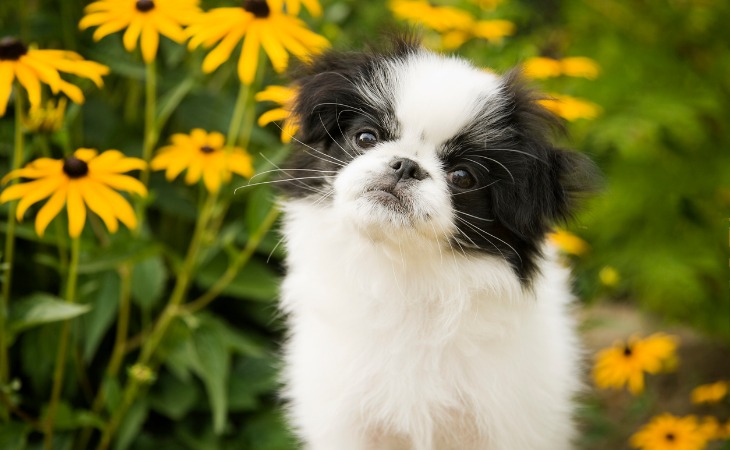
The origins of the Japanese Chin
The Japanese Chin, also called the “Japanese Spaniel” is a dog breed that originated China. The word “Chin” means royal. This dog breed was offered to the Emperor of Japan in the year 732 by Korean sovereigns.
This breed arrived in Europe around the 9th century. Many queens loved them, such as Queen Victoria and Queen Marie Antoinette.
Physical characteristics
Japanese Chins are known for their bulging eyes and their adorable faces! The breed’s coat is mainly white with other parts of the body being black or red. Regarding their noses, they can be one of two colors, brown or black.
Personality
This dog is rather pleasant to live with. They love to share their good mood with others. In addition, they adapt well to family life. This is especially so regarding families with children. Similar to the Japanese Spitz, they can be quite suspicious of strangers. Nevertheless, they do not bark a lot.
Caring for a Japanese Chin
Japanese Chins are known to be able to adapt easily to their environment. That is why they can live in both apartments and houses.
Sometimes, the Japanese Chin can have infections in their eyes or ears. It is best to keep an eye on them often. It is also recommended to pay attention to them when it is hot outside because they can have a hard time breathing. This is due to their shorter snout. Additionally, this dog is predisposed to GM2 gangliosidosis.
Japanese Chins do not need a large amount of exercise. They can be very happy with a daily walk outside.
4. Akita Inu, a large Japanese dog breed
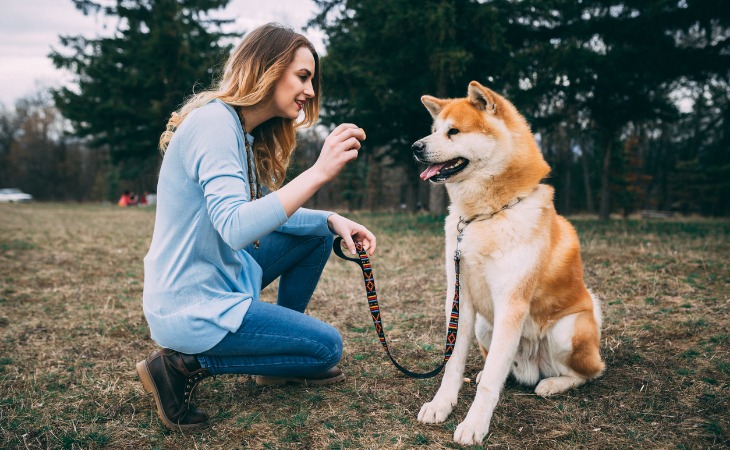
The origins of the Akita Inu
We hear a lot about the Akita Inu! The breed has become a bit of a star. The name Akita Inu is named after the Akita prefecture in the north of Japan.
They are a primitive dog breed. Originally, they were used to hunt wild boar, deer and bears. This breed has been crossed with Mastiffs and Tosas, which is why it is now one of the largest Japanese dog breeds.
At the end of the Second World War, three types of Akita Inus were identified. Among them, the Matagi Akita, the fighting Akita and the German Shepherd cross. The breed we know today was recognized as a Japanese National Monument in 1931.
Physical characteristics
The Akita Inu is a large dog breed. They have a robust physique as well. When it comes to their weight, females can weigh up to 30 kilos (around 66 pounds) and males can weigh up to twice that.
The Akita Inu’s coat can be a sesame color, red or fawn, brindle and white. In addition to this, they must have Urajiro, which is the presence of white hairs on the sides of the muzzle, the cheeks, under the jaw, on the throat, chest, and belly.
Personality
As mentioned earlier, the Akita Inu is a primitive dog breed. Therefore, they can be very assertive. Their hunting instincts makes them very active dogs with a lot of energy. For this reason, they need to be exercised daily and their owners need to be very patient regarding their training. This breed’s stubborn side could quickly make you go crazy!
Despite their stubbornness, they are adorable and affectionate dogs. Even though they are known to be independent, they will still stay close to you.
Caring for an Akita Inu
The Akita Inu is a rather healthy and robust dog. They live on average around 10 to 13 years.
If you live with children, it’s important to keep an eye on them. Because they are primitive dogs, sometimes is it difficult to anticipate their behavior.
5. Shiba Inu, the ideal Japanese dog breed
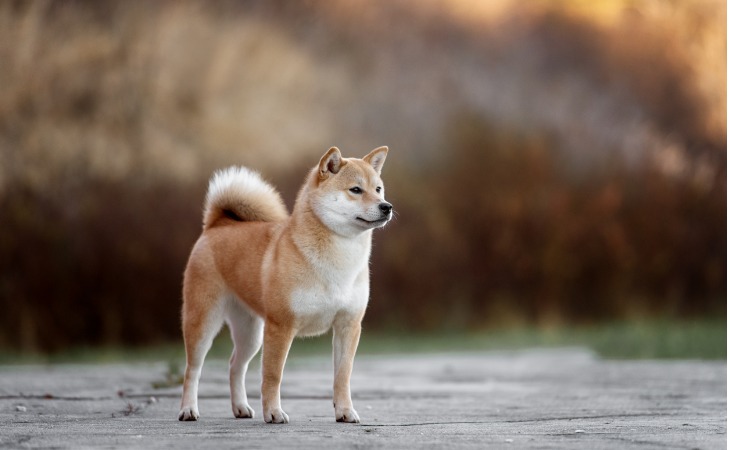
The origins of the Shiba Inu
Last but not least, we have the Shiba Inu. It is considered a primitive dog breed. Similar to the Akita Inu, the Shiba Inu originates from China. The breed arrived in Japan along with humans who were migrating at the time. They were used for hunting wild boar and foxes.
Physical characteristics
The Shiba Inu is a small dog breed that is well-proportioned.
Their coat can be of several colors: red, black and tan, cream, sesame, black sesame, and red sesame. No matter what color they are, they must have Urajiro.
Personality
In addition to being faithful and affectionate, they also get very attached to the people around them. That being said, just like all the other breeds mentioned in this article, they need a certain level of independence. Their personality, however, is easier to deal with than the Akita Inu.
Caring for a Shiba Inu
This dog breed can easily adapt to apartment life. With that being said, Shiba Inus still need to go on daily outings. This is because the Shiba Inu need to have time to use up their energy. This breed also adapts well to households with children or cats.
Lastly, the Shiba Inu is a healthy breed that usually lives beyond 10 years.

